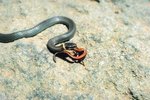
Milk snakes are North American reptiles sometimes erroneously tagged as spotted adders, even though they're not technically adders. To be specific, they are occasionally mixed up with northern Asian and European adders, which are poisonous family Viperidae snakes. Milk snakes and these adders are totally distinct entities.
Adder Confusion
Milk snakes aren't venomous, but they share one conspicuous behavior with family Viperidae adders, which may be the reason behind the puzzling and misleading name. In times of agitation, milk snakes frequently tremble their tails. Family Viperidae adders also quiver their tails a lot, especially just prior to mating. Although they have that in common, they are night and day as far as toxicity goes. "Spotted adders" or milk snakes are not poisonous. If they experience physical contact from a human, however, their fear might cause them to emit an unpleasant odor and perhaps even bite.
Geography
Milk snake haunting grounds within North America have a pretty broad scope. They essentially live all over the eastern United States -- from the Atlantic coast to the Rockies. Milk snakes also inhabit Canada and Mexico. Some live as far south as Central America.
Living Environment
Milk snakes are successful at adjusting to different kinds of living environments. For the most part, they inhabit forests, rugged outcrops, wetlands, fields, creeks, savannas and damp meadows. Milk snakes also frequently gravitate to the exteriors of farms and residences.
Physical Appearance
Colorwise, milk snakes are extremely vibrant reptiles. Their physiques are beige or pale gray, and they are adorned with patches that are a combination of black and chestnut. Mature milk snakes typically grow to between 2 and 3 feet long. Extremely long specimens can make it to 52 inches. Milk snakes generally have narrow forms.
Food
Milk snakes are flesh-eaters. When mature, their diet consists predominantly of rodents such as rats, mice, chipmunks and voles. They aren't limited to rodents, however, freely chowing down on prey such as bats, moles, fish, lizards, fellow snakes and birds. Milk snakes are also big on eggs, whether of snakes or birds. Amphibians also sometimes pop up into their diet plans. They occasionally eat slugs and bugs.
Naming
Milk snakes not only have nothing to do with adders, they are not in any way involved with cow milking, either. They are indeed common sightings on farms, though, as are cows.
References
- State University of New York College of Environmental Sciences and Forestry: Snakes of New York
- New York State Department of Environmental Conservation: Snakes of New York
- University of Michigan Animal Diversity Web: Lampropeltis triangulum
- Montana Field Guide: Milksnake
- UMass Amherst Snakes of Massachusetts: Milk Snake
- University of Michigan Animal Diversity Web: Vipera berus
Photo Credits
-
Jupiterimages/Comstock/Getty Images




